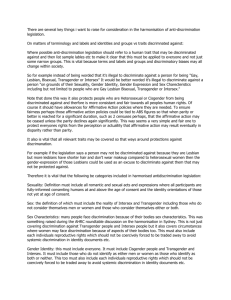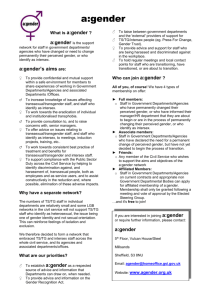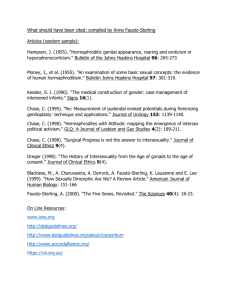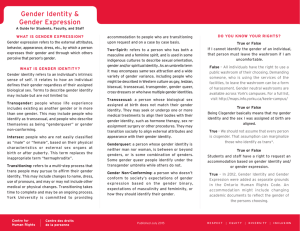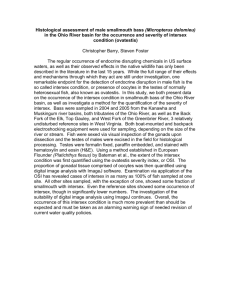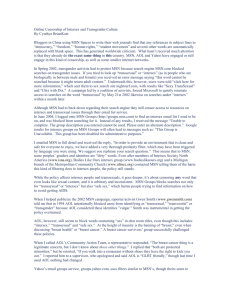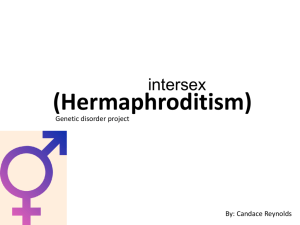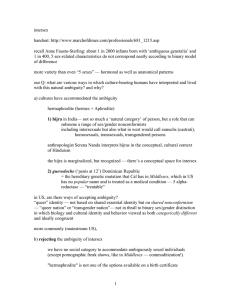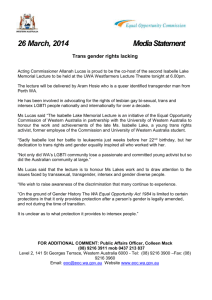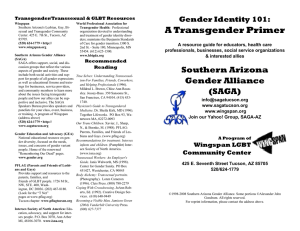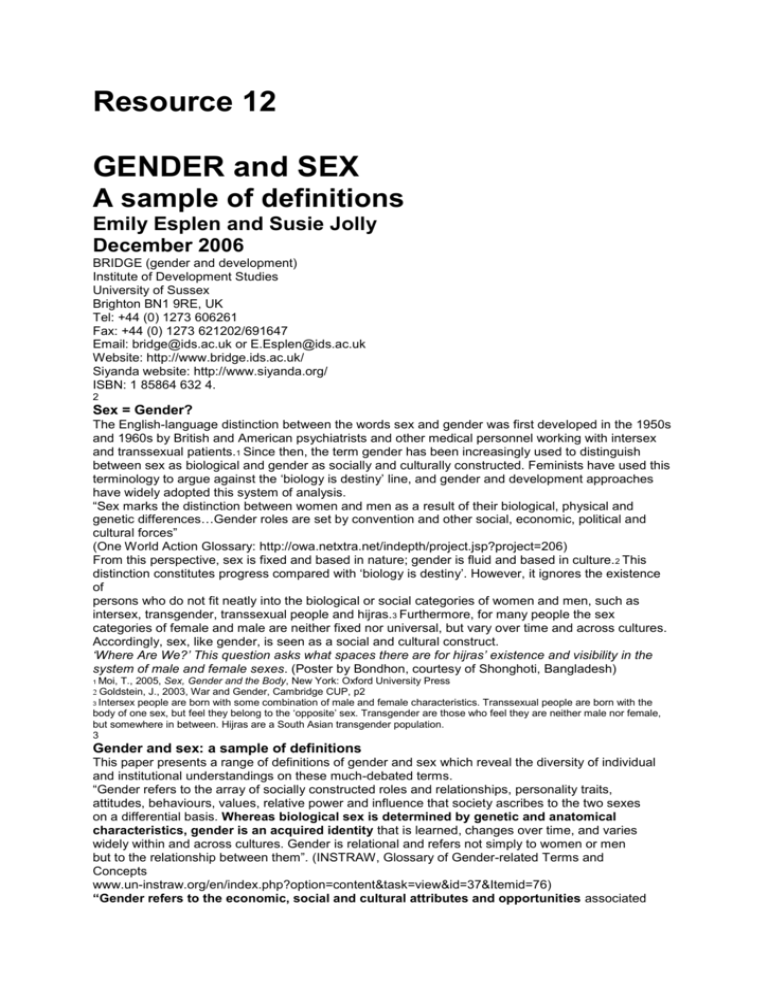
Resource 12
GENDER and SEX
A sample of definitions
Emily Esplen and Susie Jolly
December 2006
BRIDGE (gender and development)
Institute of Development Studies
University of Sussex
Brighton BN1 9RE, UK
Tel: +44 (0) 1273 606261
Fax: +44 (0) 1273 621202/691647
Email: bridge@ids.ac.uk or E.Esplen@ids.ac.uk
Website: http://www.bridge.ids.ac.uk/
Siyanda website: http://www.siyanda.org/
ISBN: 1 85864 632 4.
2
Sex = Gender?
The English-language distinction between the words sex and gender was first developed in the 1950s
and 1960s by British and American psychiatrists and other medical personnel working with intersex
and transsexual patients.1 Since then, the term gender has been increasingly used to distinguish
between sex as biological and gender as socially and culturally constructed. Feminists have used this
terminology to argue against the ‘biology is destiny’ line, and gender and development approaches
have widely adopted this system of analysis.
“Sex marks the distinction between women and men as a result of their biological, physical and
genetic differences…Gender roles are set by convention and other social, economic, political and
cultural forces”
(One World Action Glossary: http://owa.netxtra.net/indepth/project.jsp?project=206)
From this perspective, sex is fixed and based in nature; gender is fluid and based in culture. 2 This
distinction constitutes progress compared with ‘biology is destiny’. However, it ignores the existence
of
persons who do not fit neatly into the biological or social categories of women and men, such as
intersex, transgender, transsexual people and hijras.3 Furthermore, for many people the sex
categories of female and male are neither fixed nor universal, but vary over time and across cultures.
Accordingly, sex, like gender, is seen as a social and cultural construct.
‘Where Are We?’ This question asks what spaces there are for hijras’ existence and visibility in the
system of male and female sexes. (Poster by Bondhon, courtesy of Shonghoti, Bangladesh)
1 Moi,
T., 2005, Sex, Gender and the Body, New York: Oxford University Press
J., 2003, War and Gender, Cambridge CUP, p2
3 Intersex people are born with some combination of male and female characteristics. Transsexual people are born with the
body of one sex, but feel they belong to the ‘opposite’ sex. Transgender are those who feel they are neither male nor female,
but somewhere in between. Hijras are a South Asian transgender population.
3
2 Goldstein,
Gender and sex: a sample of definitions
This paper presents a range of definitions of gender and sex which reveal the diversity of individual
and institutional understandings on these much-debated terms.
“Gender refers to the array of socially constructed roles and relationships, personality traits,
attitudes, behaviours, values, relative power and influence that society ascribes to the two sexes
on a differential basis. Whereas biological sex is determined by genetic and anatomical
characteristics, gender is an acquired identity that is learned, changes over time, and varies
widely within and across cultures. Gender is relational and refers not simply to women or men
but to the relationship between them”. (INSTRAW, Glossary of Gender-related Terms and
Concepts
www.un-instraw.org/en/index.php?option=content&task=view&id=37&Itemid=76)
“Gender refers to the economic, social and cultural attributes and opportunities associated
with being male or female at a particular point in time” (World Health Organization, 2001,
Transforming health systems: gender and rights in reproductive health,
http://www.who.int/reproductive-health/gender/glossary.html)
“Sex refers to the biological characteristics that define humans as female or male. While
these sets of biological characteristics are not mutually exclusive, as there are individuals who
possess both, they tend to differentiate humans as males and females”. (World Health
Organization, 2002, Gender and Reproductive Rights: Working Definitions,
http://www.who.int/reproductive-health/gender/sexual_health.html#1)
“(Sex) in human beings is not a purely dichotomous variable. It is not an evenly continuous
one either…. a fair number of human beings are markedly intersexual, a number of them to
the point where both sorts of external genitalia appear, or where developed breasts occur in an
individual with male genitalia, and so on”. (Geertz, Clifford., 1983, Local Knowledge: Further
Essays in Interpretive Anthropology, New York: Basic Books, p81)
“If the immutable character of sex is contested, perhaps this construct called ‘sex’ is as
culturally constructed as gender; indeed, perhaps it was always already gender, with the
consequence that the distinction between sex and gender turns out to be no distinction at all”
(Butler, Judith., 1990, Gender Trouble: Feminism and the Subversion of Identity, New York &
London: Routledge, Chapter 1: Subjects of Sex/Gender/Desire, p346)
“Gender is not what culture created out of my body’s sex; rather; sex is what culture makes
when it genders my body” (Wilchins, transgender activist, quoted in Monro, Surya., 2006,
Gender Politics: Citizenship, Activism and Sexual Diversity, London: Pluto Press, p30)
4
“Gender categorisation can be best described as a large machine with lots of pins that dig
into the sense of self and tear the mind to pieces. And in my situation, having been ‘surgically
treated’ as a child…I see a lot of malice behind It” (Salamacis, quoted in Munro, S., 2006,
Gender Politics: Citizenship, Activism and Sexual Diversity, London: Pluto Press, p47)
“We believe it is indispensable to deconstruct the binary sex/gender system that shapes
the Western world so absolutely that in most cases it goes unnoticed. For ‘other sexualities to be
possible’ it is indispensable and urgent that we stop governing ourselves by the absurd notion
that only two possible body types exist, male and female, with only two genders inextricably
linked to them, man and woman. We make trans and intersex issues our priority because their
presence, activism and theoretical contributions show us the path to a new paradigm that will
allow as many bodies, sexualities and identities to exist as those living in this world might wish to
have, with each one of them respected, desired, celebrated” (International Gay and Lesbian
Human Rights Commission [IGLHRC], 2005, Institutional Memoir of the 2005 Institute for Trans
and Intersex Activist Training, p8 http://www.iglhrc.org/files/iglhrc/LAC/ITIAT-Aug06-E.pdf)
5
The Gender Puzzle
All answers: gender
Bornstein, Kate., 1998, My Gender Workbook, Routledge: New York and London, Solving the Gender
Puzzle p25



